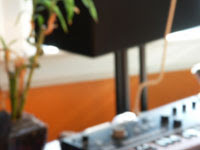 All the parts were in place; I was soldering and building the x0x carefully; I certainly spent enough time on it. I couldn't figure out why the x0x wouldn't fire up. I compiled a list of all the tests and went through them once more as a matter of quality control. I completed a battery of tests and got support through the x0x forums and covered everything from my power supply to each IC in the digital section of the pcb. It turns out that my earlier envelope issue was still at the heart of the problem. It was still causing errors and wasn't sending the correct voltage to the amp. After about 2 hours of troubleshooting I was relieved to discover that 2SC536F in Q37 was faulty. I replaced it with another one and low and behold it was fully functional! LIGHTS AND SOUND! Relief & Joy. It wasn't my shoddy set of skills. It was a dead transistor.
All the parts were in place; I was soldering and building the x0x carefully; I certainly spent enough time on it. I couldn't figure out why the x0x wouldn't fire up. I compiled a list of all the tests and went through them once more as a matter of quality control. I completed a battery of tests and got support through the x0x forums and covered everything from my power supply to each IC in the digital section of the pcb. It turns out that my earlier envelope issue was still at the heart of the problem. It was still causing errors and wasn't sending the correct voltage to the amp. After about 2 hours of troubleshooting I was relieved to discover that 2SC536F in Q37 was faulty. I replaced it with another one and low and behold it was fully functional! LIGHTS AND SOUND! Relief & Joy. It wasn't my shoddy set of skills. It was a dead transistor. Hours of jamming and more tests ensued. I had the x0x drive a TR-606 and vice versa, Ableton and ACID driving the x0x via MIDI, and even had a connection to the c0ntr0l software.
Hours of jamming and more tests ensued. I had the x0x drive a TR-606 and vice versa, Ableton and ACID driving the x0x via MIDI, and even had a connection to the c0ntr0l software. After a good week and a half or so of just enjoying the synth I finally sat down and tuned it as well. It's by no means a complicated step but it does require a bit of patience. The forums suggest setting the tempo to its lowest speed, setting up a low C and middle C, both with long slides and decays and using a tuner to match it all up. This method worked beautifully for me via Wavelab 6 and a free tuner VST.
After a good week and a half or so of just enjoying the synth I finally sat down and tuned it as well. It's by no means a complicated step but it does require a bit of patience. The forums suggest setting the tempo to its lowest speed, setting up a low C and middle C, both with long slides and decays and using a tuner to match it all up. This method worked beautifully for me via Wavelab 6 and a free tuner VST.I must say that I thought the x0x sounded amazing when I got it working but hearing it tuned properly really makes it sing. *Now* we have an instrument here!



